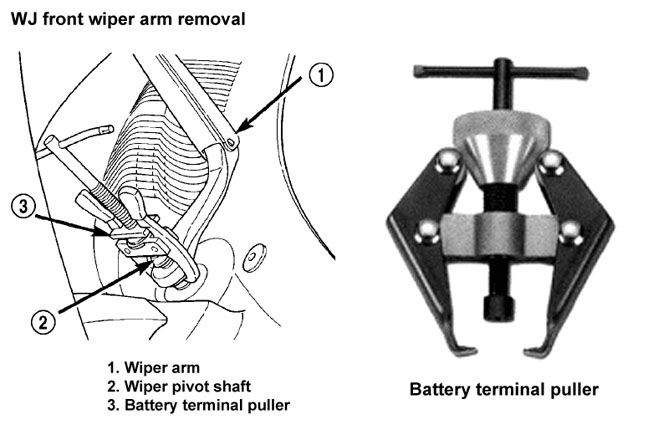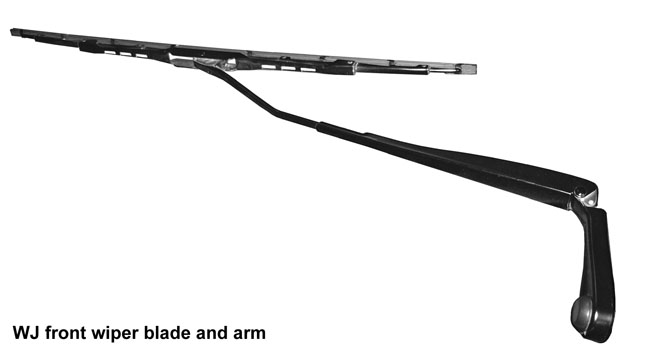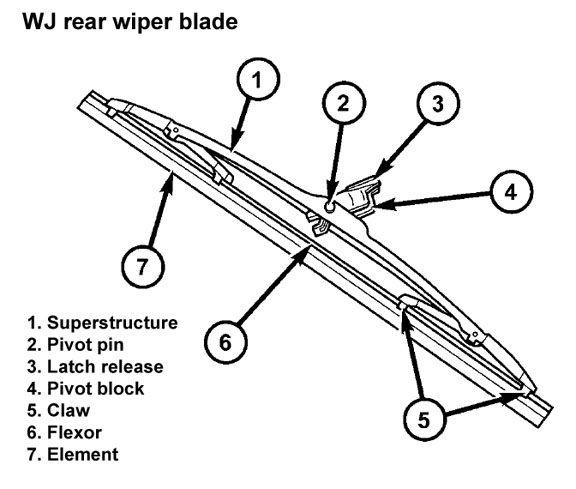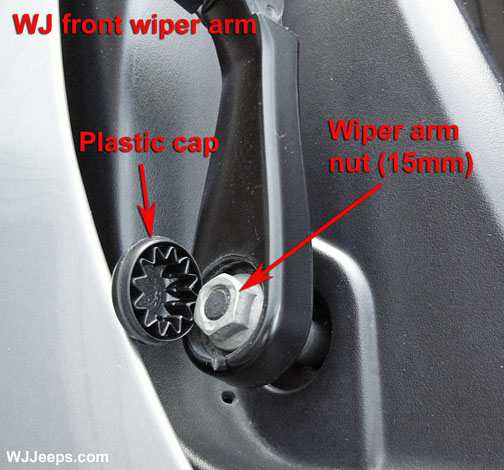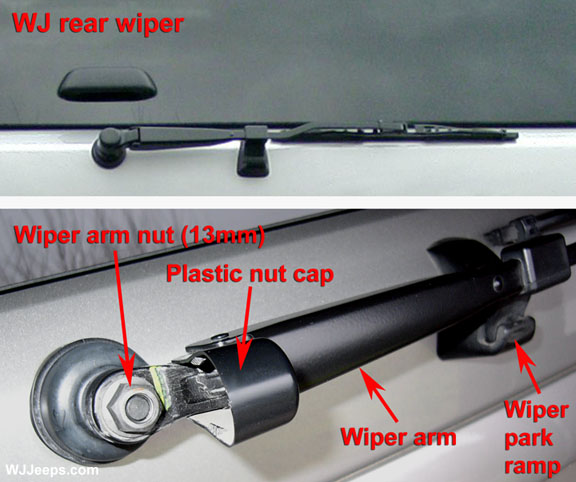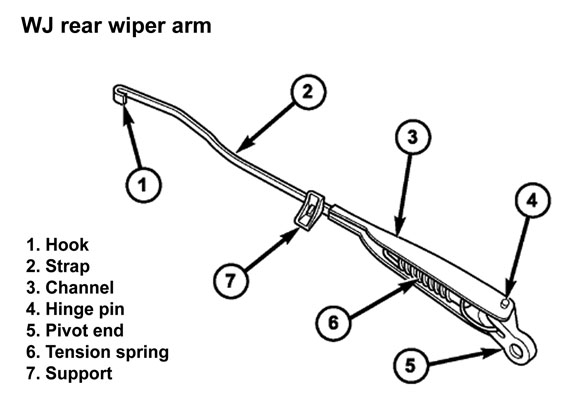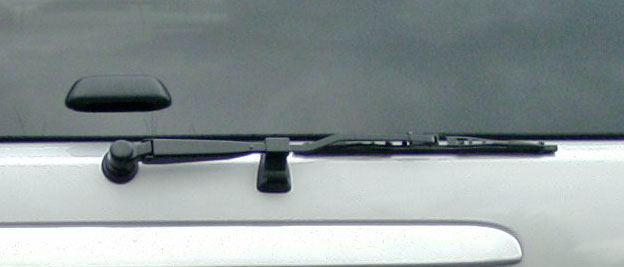Welcome to the JeepSpecs.com in-depth page on WJ Generation Jeep Grand Cherokee front and rear wiper systems. We have organized as much information as we could find into a helpful table below. Is something incorrect or missing? Please get in touch with us and we’ll fix it!
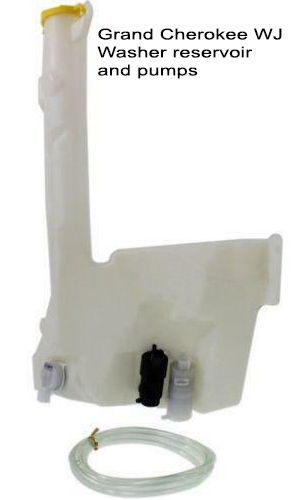
Grand Cherokee wiper switch and wiper reservoir
Front wiper and washer system
An electrically operated intermittent front wiper and washer system is standard factory-installed safety equipment on all WJ models. A Rain Sense wiper system was introduced starting with the 2002 model year (standard on Overland’s and optional on Limited’s).
Front wiper system components:
FRONT CHECK VALVE
The front washer system check valve is integral to the wye fitting located in the washer plumbing between the cowl plenum washer hose and the front washer nozzles, and is concealed beneath the cowl plenum cover/grille panel at the base of the windshield.
FRONT WASHER NOZZLE
Two fluidic front washer nozzles are secured with integral snap features to dedicated openings in the cowl plenum cover/ grille panel located near the base of the windshield.
FRONT WASHER PLUMBING
The plumbing for the front washer system consists of rubber hoses and molded plastic fittings. The plumbing is routed along the left side of the engine compartment from the washer reservoir, and through the dash panel into the cowl plenum beneath the cowl plenum cover/ grille panel to the front washer nozzle fittings.
FRONT WASHER PUMP/MOTOR
The front washer pump/motor unit is located in a dedicated hole on the lower outboard side of the washer reservoir, behind the inner fender liner ahead of the left front wheel. The front washer pump is located ahead of and below the rear washer pump.
FRONT WIPER ARM
The two front wiper arms are secured with nuts to the threaded studs on the ends of the two wiper pivot shafts, which extend through the cowl plenum cover/grille panel located near the base of the windshield.
FRONT WIPER BLADE
The two front wiper blades are secured to the two front wiper arms with an integral latch, and are parked on the glass near the bottom of the windshield when the front wiper system is not in operation.
FRONT WIPER MODULE
The front wiper pivot shafts are the only visible components of the front wiper module. The remainder of the module is concealed within the cowl plenum beneath the cowl plenum cover/grille panel. The front wiper module includes the wiper module bracket, four rubber-isolated wiper module mounts, the front wiper motor, the wiper motor crank arm, the two wiper drive links, and the two front wiper pivots.
RAIN SENSOR MODULE
Models equipped with the optional automatic wiper feature have a Rain Sensor Module (RSM) located behind a trim cover on a bracket bonded to the inside surface of the windshield glass, just above the inside rear view mirror mounting button.
RIGHT MULTI-FUNCTION SWITCH
The right (wiper) multi-function switch is secured to the right side of the multi-function switch mounting housing near the top of the steering column, just below the steering wheel. Only the control stalk for the right multi-function switch is visible, while the remainder of the switch is concealed beneath the steering column shrouds. The right multi-function switch contains all of the switches and control circuitry for both the front and rear wiper and washer systems.
WASHER FLUID LEVEL SWITCH
The washer fluid level switch is located in a dedicated hole near the center of the forward facing surface of the washer reservoir, behind the left front wheel house splash shield.
WASHER RESERVOIR
The washer reservoir is concealed between the left inner fender shield and the left outer fender panel, behind the inner fender liner and ahead of the left front wheel. The washer reservoir filler neck is the only visible portion of the reservoir, and it is accessed from the left front corner of the engine compartment.
WIPER HIGH-LOW RELAY
The wiper high-low relay is an International Standards Organization (ISO) micro relay located in the Power Distribution Center (PDC) in the engine compartment near the battery.
WIPER ON-OFF RELAY
The wiper on-off relay is an International Standards Organization (ISO) micro relay located in the Power Distribution Center (PDC) in the engine compartment near the battery. Hard wired circuitry connects the front wiper and washer system components to the electrical system of the vehicle. These hard wired circuits are integral to several wire harnesses, which are routed throughout the vehicle and retained by many different methods. These circuits may be connected to each other, to the vehicle electrical system and to the front wiper and washer system components through the use of a combination of soldered splices, splice block connectors, and many different types of wire harness terminal connectors and insulators. Refer to the appropriate wiring information. The wiring information includes wiring diagrams, proper wire and connector repair procedures, further details on wire harness routing and retention, as well as pin-out and location views for the various wire harness connectors, splices and grounds..
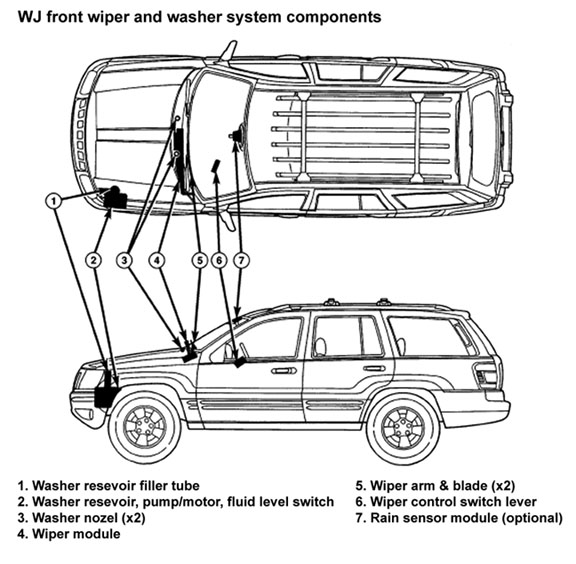
WJ front wiper and washer system components
Front wiper operating modes
The components of the front wiper and washer system are designed to work in concert to provide the following operating modes:
AUTOMATIC WIPE MODE
In models equipped with the optional automatic wiper feature, the internal circuitry of both the right (wiper) multi-function switch, the rain sensor module, and the BCM work in concert to provide an automatic wiper mode with five sensitivity selections. When selected, this switch position will automatically operate the front wipers at the programmed speed and intervals to maintain visibility through the windshield glass.
CONTINUOUS WIPE MODE
The control knob on the control stalk of the right (wiper) multi-function switch has two continuous wipe positions, Low and High. When selected, these switch positions will cause the two-speed front wiper motor to operate in a continuous low or high speed cycle.
HEADLAMPS ON WITH WIPERS MODE
The BCM provides an automatic headlamps on with wipers feature for models equipped with the optional automatic headlamps. This is a customer programmable feature. If this feature is enabled, the headlamps will turn on automatically whenever the windshield wipers are turned on; and, if the headlamps were turned on automatically when the wipers were turned on, they will also turn off automatically when the wipers are turned off. If this feature is enabled in models equipped with the optional automatic wiper feature, when the automatic wiper mode is selected the headlamps will turn on automatically only after the wipers complete three automatic wipe cycles within about thirty seconds, and they will turn off automatically after three minutes elapse without any automatic wipe cycles.
MIST WIPE MODE
The control stalk of the right (wiper) multi-function switch has a momentary Mist position. When selected, this switch position will operate the front wipers in a low speed continuous cycle for as long as the switch is held closed, then will complete the current wipe cycle and park the front wiper blades near the base of the windshield when the switch is released.
SPEED SENSITIVE INTERMITTENT WIPE MODE
Except on models equipped with the optional automatic wiper system, the internal circuitry of both the right (wiper) multi-function switch and the BCM work in concert to provide an intermittent wipe mode with five delay interval selections. When this mode is selected, the BCM automatically adjusts each of the five manually selected delay intervals between complete wipe cycles to compensate for vehicle speed.
WASHER MODE
When the momentary front wash position of the control stalk for the right (wiper) multi-function switch is selected with the front wiper system operating in a continuous wipe mode, washer fluid will be dispensed onto the windshield glass through the washer nozzles for as long as the washer switch is held closed. When the front washer switch is actuated with the front wiper system operating in an intermittent wipe mode, washer fluid is still dispensed until the switch is released; however, the front wipers will operate in a low speed continuous cycle from the time the washer switch is closed until several wipe cycles after the switch is released, before returning to the selected intermittent wipe mode.
WIPE-AFTER-WASH MODE
When the momentary front wash position of the control stalk for the right (wiper) multi-function switch is selected with the front wiper system turned Off, the internal circuitry of the BCM provides a wipe-after-wash feature. When selected, this feature will operate the front washer pump/motor and the front wipers for as long as the front washer switch is held closed, then provide several additional wipe cycles after the switch is released before parking the front wiper blades near the base of the windshield.
Front wiper operating modes
The components of the front wiper and washer system are designed to work in concert to provide the following operating modes:
AUTOMATIC WIPE MODE
In models equipped with the optional automatic wiper feature, the internal circuitry of both the right (wiper) multi-function switch, the rain sensor module, and the BCM work in concert to provide an automatic wiper mode with five sensitivity selections. When selected, this switch position will automatically operate the front wipers at the programmed speed and intervals to maintain visibility through the windshield glass.
CONTINUOUS WIPE MODE
The control knob on the control stalk of the right (wiper) multi-function switch has two continuous wipe positions, Low and High. When selected, these switch positions will cause the two-speed front wiper motor to operate in a continuous low or high speed cycle.
HEADLAMPS ON WITH WIPERS MODE
The BCM provides an automatic headlamps on with wipers feature for models equipped with the optional automatic headlamps. This is a customer programmable feature. If this feature is enabled, the headlamps will turn on automatically whenever the windshield wipers are turned on; and, if the headlamps were turned on automatically when the wipers were turned on, they will also turn off automatically when the wipers are turned off. If this feature is enabled in models equipped with the optional automatic wiper feature, when the automatic wiper mode is selected the headlamps will turn on automatically only after the wipers complete three automatic wipe cycles within about thirty seconds, and they will turn off automatically after three minutes elapse without any automatic wipe cycles.
MIST WIPE MODE
The control stalk of the right (wiper) multi-function switch has a momentary Mist position. When selected, this switch position will operate the front wipers in a low speed continuous cycle for as long as the switch is held closed, then will complete the current wipe cycle and park the front wiper blades near the base of the windshield when the switch is released.
SPEED SENSITIVE INTERMITTENT WIPE MODE
Except on models equipped with the optional automatic wiper system, the internal circuitry of both the right (wiper) multi-function switch and the BCM work in concert to provide an intermittent wipe mode with five delay interval selections. When this mode is selected, the BCM automatically adjusts each of the five manually selected delay intervals between complete wipe cycles to compensate for vehicle speed.
WASHER MODE
When the momentary front wash position of the control stalk for the right (wiper) multi-function switch is selected with the front wiper system operating in a continuous wipe mode, washer fluid will be dispensed onto the windshield glass through the washer nozzles for as long as the washer switch is held closed. When the front washer switch is actuated with the front wiper system operating in an intermittent wipe mode, washer fluid is still dispensed until the switch is released; however, the front wipers will operate in a low speed continuous cycle from the time the washer switch is closed until several wipe cycles after the switch is released, before returning to the selected intermittent wipe mode.
WIPE-AFTER-WASH MODE
When the momentary front wash position of the control stalk for the right (wiper) multi-function switch is selected with the front wiper system turned Off, the internal circuitry of the BCM provides a wipe-after-wash feature. When selected, this feature will operate the front washer pump/motor and the front wipers for as long as the front washer switch is held closed, then provide several additional wipe cycles after the switch is released before parking the front wiper blades near the base of the windshield.
Rear wiper and washer system
An electrically operated fixed interval intermittent rear wiper and washer system is standard factory-installed equipment on all WJ models.
Rear wiper and washer system components:
REAR WASHER NOZZLE
The rear washer nozzle is secured by a snap fit into a mounting hole in the liftgate outer panel above the liftgate glass. The rear washer nozzle includes an integral rear check valve.
REAR WASHER PLUMBING
The plumbing for the rear washer system consists of rubber hoses and molded plastic fittings. The plumbing is routed along the left side of the engine compartment from the washer reservoir, through the dash into the passenger compartment, up the left cowl side and A-pillar to the headliner, and above the headliner to the rear roof header. The plumbing is then routed through grommets in the rear roof header and the liftgate inner panel to the fitting for the rear washer nozzle.
REAR WASHER PUMP/MOTOR
The rear washer pump/motor unit is located in a dedicated hole on the lower outboard side of the washer reservoir, ahead of the left front wheel housing. The rear washer pump mounting hole is located higher on the reservoir than the front washer pump mounting hole.
REAR WIPER ARM
The single rear wiper arm is secured by a nut directly to the rear wiper motor output shaft, which extends through the center of the liftgate outer panel near the base of the liftgate flip-up glass.
REAR WIPER ARM PARK RAMP
The molded rubber rear wiper arm park ramp is secured with a screw to the liftgate outer panel to the right of the rear wiper motor output shaft bezel. When the rear wiper system is not in operation, the rear wiper arm is parked off of the flip-up glass on this ramp so that it will not interfere with or be damaged by the flip-up glass operation.
REAR WIPER BLADE
The single rear wiper blade is secured to the rear wiper arm with an integral latch, and is parked off of the liftgate flip-up glass when the rear wiper system is not in operation.
REAR WIPER MODULE
The rear wiper motor output shaft is the only visible component of the rear wiper module. The remainder of the module is concealed within the liftgate beneath the liftgate flip-up glass opening. The rear wiper module includes the module bracket, the rear wiper motor, and the rear wiper electronic control circuitry.
RIGHT MULTI-FUNCTION SWITCH
The right (wiper) multi-function switch is secured to the right side of the multi-function switch mounting housing near the top of the steering column, just below the steering wheel. Only the control stalk for the right multi-function switch is visible. The remainder of the switch is concealed beneath the steering column shrouds. The right multi-function switch control stalk is dedicated to providing all of the driver controls for both the front and rear wiper and washer systems.
WASHER RESERVOIR
The rear washer system shares a single reservoir with the front washer system, but has its own dedicated washer pump/motor and plumbing. The washer reservoir is concealed between the left inner fender shield and the left outer fender panel, behind the inner fender liner and ahead of the left front wheel. The washer reservoir filler neck is the only visible portion of the reservoir, and it is accessed from the left front corner of the engine compartment. Hard wired circuitry connects the rear wiper and washer system components to the electrical system of the vehicle. These hard wired circuits are integral to several wire harnesses, which are routed throughout the vehicle and retained by many different methods. These circuits may be connected to each other, to the vehicle electrical system and to the rear wiper and washer system components through the use of a combination of soldered splices, splice block connectors, and many different types of wire harness terminal connectors and insulators. Refer to the appropriate wiring information. The wiring information includes wiring diagrams, proper wire and connector repair procedures, further details on wire harness routing and retention, as well as pin-out and location views for the various wire harness connectors, splices and grounds.
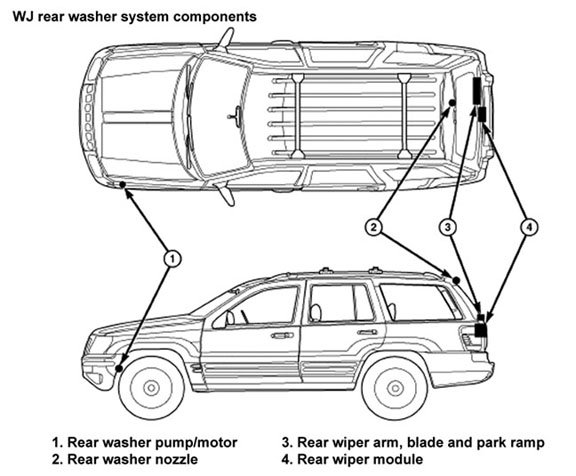
Rear wiper operating modes
CONTINUOUS WIPE MODE
When the right multi-function switch control sleeve is moved to the On position, the rear wiper will be operated at a fixed speed, continual wipe cycle until the switch sleeve is moved to the Delay or Off positions, until the ignition switch is turned to the Off position, or until the liftgate flip-up glass is ajar.
INTERMITTENT WIPE MODE
When the right multi-function switch control sleeve is moved to the Delay position, the rear wiper will be operated in a fixed interval, intermittent wipe cycle until the switch sleeve is moved to the On or Off positions, until the ignition switch is turned to the Off position, until the liftgate flip-up glass is ajar, or until the right multi-function switch control stalk is pushed forward to activate the rear washer system. The intermittent wipe mode delay time has a fixed delay interval of about five to eight seconds between sweeps.
WASHER MODE
When the right multi-function switch control stalk is pushed forward to activate the rear washer system, washer fluid will be dispensed from the washer reservoir onto the liftgate glass through the rear washer nozzle and the rear wiper will operate in a fixed cycle (not intermittent) for as long as the rear washer pump/motor unit remains energized.
WIPE-AFTER-WASH MODE
When the right multi-function switch control stalk is released from the momentary Wash position, the wipe-after-wash feature will continue to operate the rear wiper at a fixed cycle for about three additional wiper sweeps before returning to the previously selected mode.
Front wiper blade and arm removal
| NOTE: All Grand Cherokee WJ models have two 20.67 inch windshield wiper blades with non-replaceable rubber elements (squeegees). The wiper blades cannot be adjusted or repaired. If faulty, worn, or damaged the entire wiper blade unit must be replaced. |
Front blade removal:
1. Lift the front wiper arm to raise the wiper blade and element off of the glass, until the wiper arm hinge is in its over-center position.
2. To remove the wiper blade from the wiper arm, depress the pivot block latch release tab under the tip of the arm and slide the blade away from the tip towards the pivot end of the arm far enough to disengage the pivot block from the hook formation on the end of the arm.
4. Extract the hook formation on the tip of the wiper arm from the opening in the wiper blade superstructure just ahead of the wiper blade pivot block/latch unit.
CAUTION: Do not allow the wiper arm to spring back against the glass without the wiper blade in place or the glass may be damaged.
5. Gently lower the tip of the wiper arm onto the glass.
Front blade installation:
NOTE: The notched end of the wiper element flexor should always be oriented towards the end of the wiper blade that is nearest to the wiper pivot.
1. Lift the front wiper arm off of the windshield glass, until the wiper arm hinge is in its over-center position.
2. Position the front wiper blade near the hook formation on the tip of the arm with the notched end of the wiper element flexor oriented towards the end of the wiper arm that is nearest to the wiper pivot.
3. Insert the hook formation on the tip of the wiper arm through the opening in the wiper blade superstructure ahead of the wiper blade pivot block/ latch unit far enough to engage the pivot block with the hook.
4. Slide the wiper blade pivot block/latch up into the hook formation on the tip of the wiper arm until the latch release tab snaps into its locked position. Latch engagement will be accompanied by an audible click.
5. Gently lower the wiper blade onto the glass.
Front arm removal:
| Wiper arm nut and cap | Wiper arm removal tool | Front wiper arm |
|---|
1. Lift the front wiper arm to its over-center position to hold the wiper blade off of the glass and relieve the spring tension on the wiper arm.
2. Carefully pry the plastic nut cap off of the pivot end of the wiper arm.
3. With a 15mm socket, remove the nut that secures the wiper arm to the wiper pivot shaft.
4. If necessary, use a suitable battery terminal puller to disengage the wiper arm from the wiper pivot shaft
5. Remove the front wiper arm pivot end from the wiper pivot shaft.
Front arm installation:
NOTE: Be certain that the wiper motor is in the park position before attempting to install the front wiper arms. Turn the ignition switch to the On position and move the right (wiper) multi-function switch control knob to its Off position. If the wiper pivots move, wait until they stop moving, then turn the ignition switch back to the Off position. The wiper motor is now in its park position.
1. The front wiper arms must be indexed to the wiper pivot shafts with the wiper motor in the park position to be properly installed. Position the front wiper arm pivot ends onto the wiper pivot shafts so that the lower edge of the blade is aligned with the wiper alignment lines located in the lower edge of the windshield glass.
2. Once the wiper blade is aligned, lift the wiper arm away from the windshield slightly to relieve the spring tension on the pivot end and push the pivot hole on the end of the wiper arm down firmly and evenly over the wiper pivot shaft.
3. Install and tighten the nut that secures the wiper arm to the wiper pivot shaft. Tighten the nut to 24 N·m (18 ft. lbs.).
4. Wet the windshield glass, then operate the front wipers. Turn the front wipers Off, then check for the correct wiper arm position and readjust as required.
5. Reinstall the plastic nut cap onto the wiper arm pivot nut.
Rear wiper blade and arm removal
| Rear windshield wiper | Rear wiper blade parts |
|---|
| NOTE: All Grand Cherokee WJ models have a single 12-inch rear wiper blade with a non-replaceable rubber element (squeegee). The wiper blade cannot be adjusted or repaired. If faulty, worn, or damaged the entire wiper blade unit must be replaced. |
Rear blade removal:
1. Disengage the rear wiper arm support from the rubber rear wiper arm park ramp on the right side of the liftgate just below the liftgate flip-up glass.
2. Lift the rear wiper arm to engage the arm hinge in its over-center position with the wiper blade and element off of the liftgate and the glass.
3. To remove the wiper blade from the wiper arm, push the pivot block latch release tab under the tip of the arm and slide the blade away from the tip towards the rear wiper motor output shaft end of the arm.
4. Slide the rear wiper blade away from the tip of the arm towards the pivot end of the arm far enough to disengage the pivot block from the hook formation on the end of the arm.
5. Extract the hook formation on the tip of the wiper arm from the opening in the wiper blade superstructure ahead of the wiper blade pivot block/latch unit.
CAUTION: Do not allow the wiper arm to spring back against the liftgate or the glass without the wiper blade in place or they may be damaged.
6. Gently lower the wiper arm and place the arm support in the park ramp.
Rear blade installation:
NOTE: The notched end of the wiper element flexor should always be oriented towards the end of the wiper blade that is nearest to the rear wiper motor output shaft.
1. Lift the rear wiper arm off of the liftgate park ramp.
2. Position the rear wiper blade near the hook formation on the tip of the arm with the notched end of the wiper element flexor oriented towards the end of the wiper arm that is nearest to the rear wiper motor output shaft.
3. Insert the hook formation on the tip of the wiper arm through the opening in the wiper blade superstructure ahead of the wiper blade pivot block/ latch unit far enough to engage the pivot block with the hook.
4. Slide the wiper blade pivot block/latch up into the hook formation on the tip of the wiper arm until the latch release tab snaps into its locked position.
5. Gently lower the wiper arm and place the arm support on the park ramp.
Rear arm removal:
| Wiper arm nut and cap | Wiper arm removal tool | Front wiper arm |
|---|
1. Carefully pry the plastic nut cap off of the nut on the rear wiper motor output shaft end of the wiper arm. This can usually be done without a tool.
2. Using a 13mm socket or wrench, remove the nut that secures the rear wiper arm to the rear wiper motor output shaft.
3. Lift the rear wiper arm far enough to engage the over-center arm hinge in its upright position to hold the wiper blade off of the liftgate.
4. If necessary, use a battery terminal puller to disengage the wiper arm from the rear wiper motor output shaft splines.
5. Remove the rear wiper arm pivot end from the motor output shaft.
Rear arm installation:
1. The rear wiper arm must be indexed to the motor output shaft with the rear wiper motor in the park position to be properly installed. Place the wiper arm onto the liftgate with the wiper arm support positioned on the park ramp and the tapered mounting hole on the pivot end of the arm positioned over the rear wiper motor output shaft.
2. With the wiper arm in the Installation Position, push the tapered mounting hole on the pivot end of the wiper arm down over the rear wiper motor output shaft.
3. Install and tighten the nut that secures the rear wiper arm to the rear wiper motor output shaft. Tighten the nut to 18 N·m (13 ft. lbs.)
4. Reinstall the plastic nut cap over the nut on the rear wiper motor output shaft end of the rear wiper arm.
5. Lift the rear wiper arm support away from the park ramp, then place the wiper arm support in the park ramp in the Park Position.

